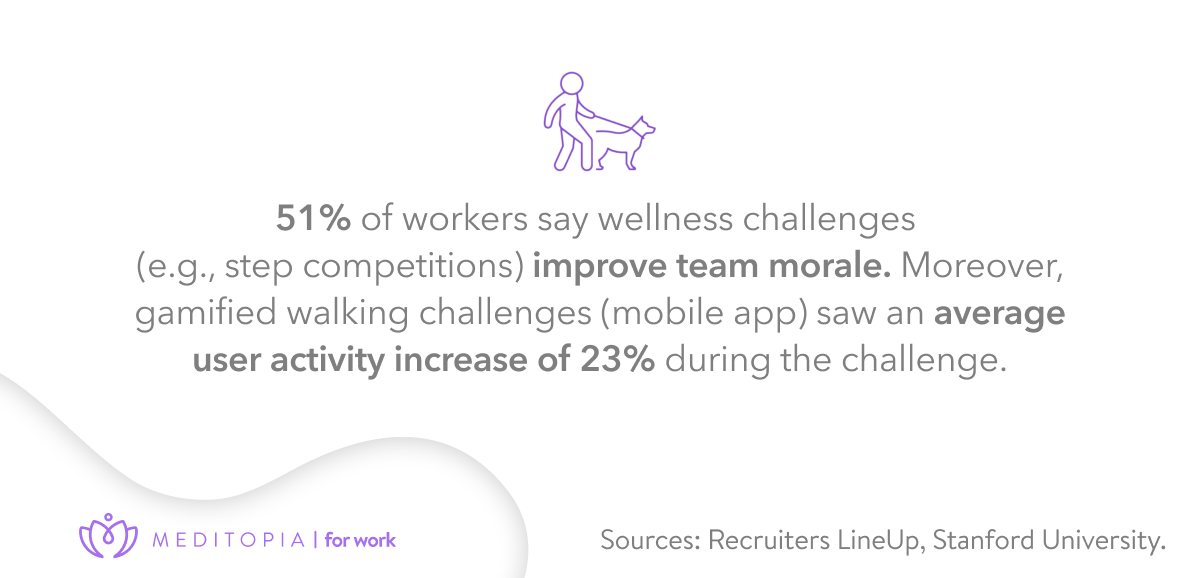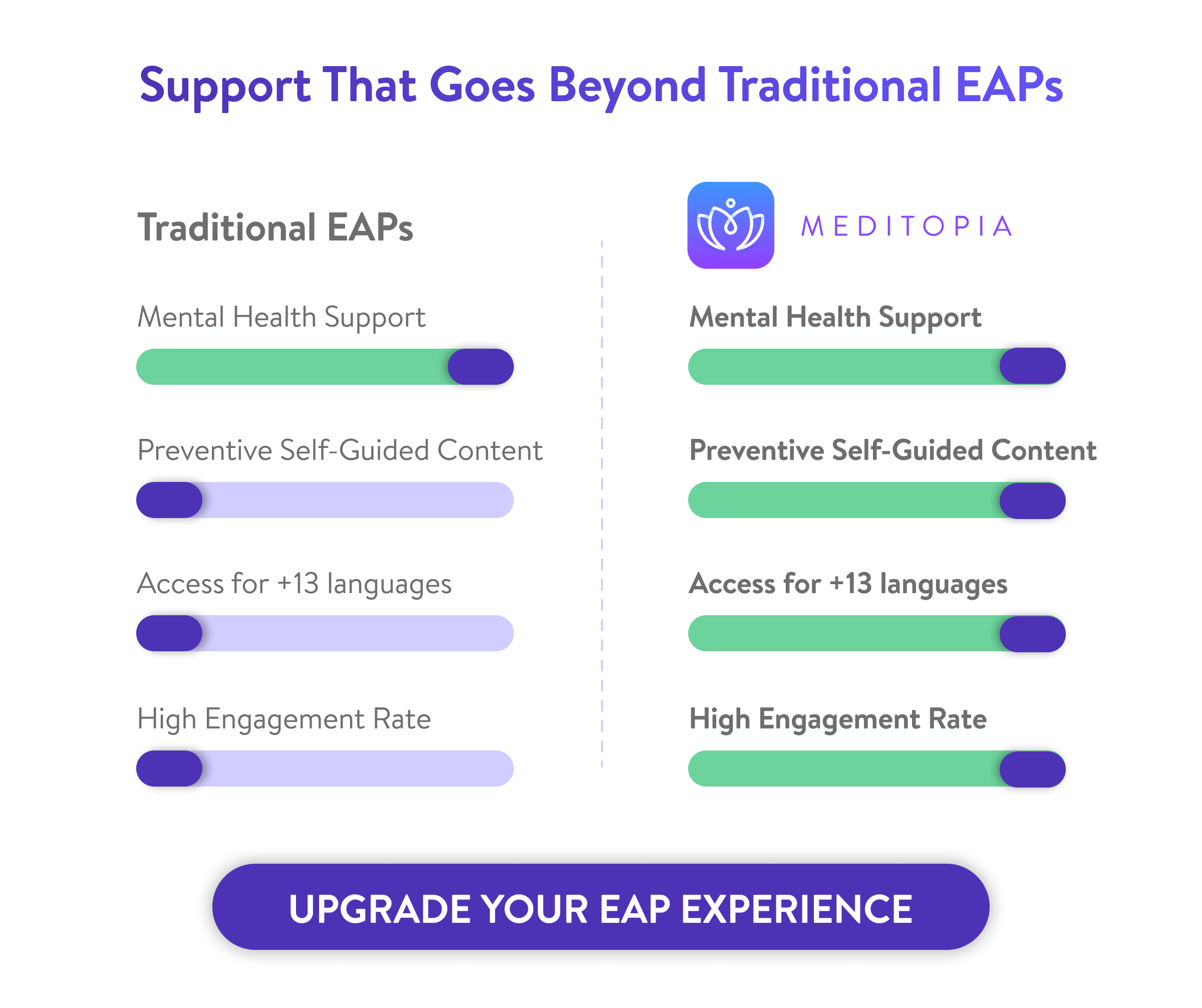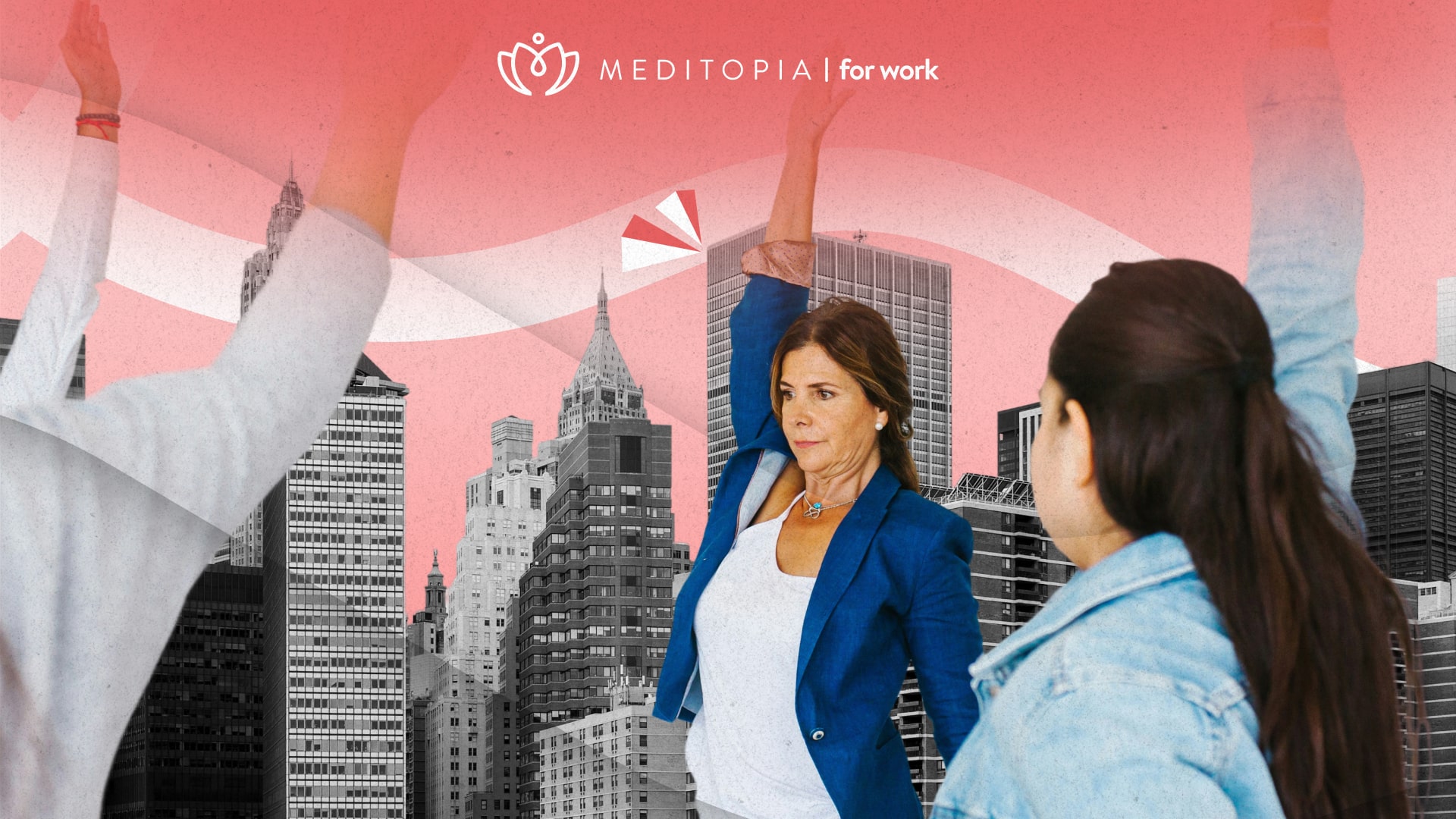Physical inactivity is now one of the biggest workplace health concerns. In fact, more than 31 % of people worldwide spend over eight hours a day sitting, putting them at risk of cardiovascular disease, obesity, and premature mortality [1]. On thevother hand, corporate fitness challenge apps address both sides of this problem, helping employees counter inactivity while improving engagement, morale, and team cohesion. Let's discover more.
Why Corporate Fitness Challenges Boost Employee Wellness
According to the World Health Organization (2024), insufficient physical activity is linked to 4-5 million preventable deaths annually, making it one of the top global health risks [2]. For employers, that translates into rising health-care costs, absenteeism, and reduced engagement.
- Research estimates that physically inactive employees cost employers $1,313 more in annual health-care expenses than their active peers [3].
- Moreover, a meta-analysis found that well-implemented workplace wellness programs yield an average ROI of $3.27 for every dollar spent on health costs [4].
- Meditopia's corporate fitness challenges work; by setting shared goals, like step counts, virtual workouts, or mindfulness streaks, we apply behavioral science to nudge employees toward movement and consistency.
- Employees who meet recommended activity levels (150 minutes of moderate exercise weekly) lower their risk of heart disease and diabetes by roughly 30% [5].
- Research has also found that adults who exercised experienced 43% fewer days of poor mental health each month than those who didn’t [6].
- A review linked shared physical-activity initiatives with measurable improvements in trust and morale among coworkers [7].
Essentially, a well-designed corporate fitness challenge app turns wellbeing into a shared goal rather than an individual effort: creating healthier, happier teams.

Limitations of Traditional Fitness Challenges
You know what they say: Not everything that glitters is gold. Before digital wellness platforms, companies relied on manual tracking likespreadsheets, paper logs, or simple step counters. These “old school” methods had clear limits:
- Low participation: Without incentives or social interaction, engagement quickly declines.
- Tracking errors: Manual data entry makes it hard to verify results.
- Lack of scalability: Office-based challenges exclude hybrid and global teams.
- One-size-fits-all approach: Traditional challenges can’t personalize experiences by fitness level or accessibility needs.
Modern corporate wellness program apps like Meditopia for Work solve these issues with real-time tracking, gamified leaderboards, and integrations for both remote and onsite employees. The result is a more inclusive, scalable, and engaging experience.
Popular Corporate Fitness Challenge Apps and Platforms
The best platforms offer flexibility, analytics, and social motivation. Below are some widely used platforms that help organizations implement team wellness challenges effectively.
- Vantage Fit: Focuses on step and workout tracking with social leaderboards and corporate rewards.
- Meditopia for Work: Combines step tracking, workouts, meditation, and emotional wellbeing through one platform. Designed for hybrid teams, it includes engagement analytics and wellness gamification.
- YuMuuv: Enables fully customizable fitness challenges for global teams, supporting both physical and mindfulness activities.
- Teamfit: Encourages group competitions with team-based tracking and leaderboards.
- Wellable: Integrates wearable data and offers comprehensive corporate wellness challenge programs.
- GoJoe: Uses social competition to keep employees motivated through friendly team rivalries.

Wellness Challenges That Drive Engagement
As research has suggested, employees who feel connected to their team are 3.2 times more likely to report overall wellbeing at work [8]. This means the goal os the challenge must also include this community feeling. A sort of healthy competition. Here are 13 examples of wellness challenges that consistently drive engagement across different workplace types:
- Step competitions: Still one of the easiest and most inclusive activities. Pair them with virtual leaderboards or team milestones to keep motivation high.
- Mindfulness streaks: Encourage employees to meditate or take short breathing breaks each day. Even 5–10 minutes reduces stress and improves focus.
- Hydration goals: Participants aim to drink a target number of water glasses per day. Simple, trackable, and effective for remote teams.
- Sleep improvement challenges: Employees commit to consistent bedtimes or tracking sleep hours for better recovery and focus.
- Digital detox week: Encourage reduced screen time or “no-email after 8 p.m.” policies to promote mental rest.
- Healthy recipe swaps: Teams share and vote on balanced meal ideas to make nutrition more social.
- Group workouts: Hybrid-friendly classes such as yoga, Pilates, or strength training that can be joined from home or office. At Meditopia, we give your team access to hundreds of gym studios in your city to increase the health benefits of exercise.
- Random acts of kindness challenge: Participants perform small acts of kindness for coworkers or their communities — reinforcing purpose and empathy.
- Gratitude journaling challenge: Encourages reflection and positive psychology habits that improve morale.
- Charity-linked step or movement challenge: Every milestone converts to a donation — merging wellbeing with social impact.
- Sustainability challenge: Reward employees for eco-friendly actions like biking to work or reducing single-use plastics, combining physical activity with purpose.
- Micro-break challenge: Remind teams to take short movement or stretch breaks throughout the day to reduce fatigue and increase productivity.
- Team recognition challenge: Encourage employees to send appreciation notes or kudos through internal platforms to strengthen connection and trust.
Building a Scalable Corporate Fitness Challenge Program
A well-designed corporate fitness challenge apps can improve your team's wellbeing, but only if the program is built with strategic alignment, clear communication, and measurable outcomes in mind. Here are some suggestions to get you started:
- Start with clear objectives and KPIs: Before launching, define what success looks like: reduced absenteeism, higher engagement scores, or increased average steps and workouts logged. Establish baseline data (such as participation rates in existing wellbeing activities) to measure improvement later.
- Segment your workforce: Different employee groups have different motivations. Some thrive on competition (sales teams), others prefer collaboration (creative or support roles). A scalable program allows challenge customization by department, location, or role so everyone feels included.
- Prioritize accessibility and hybrid readiness: With distributed teams, scalability depends on inclusivity. Choose a wellness incentives for employees that: Syncs with wearables and mobile devices, supports virtual wellness platforms for remote teams, offers localized language and time-zone flexibility, allows offline tracking options for employees without devices
- Integrate with your existing HR ecosystem: Integration ensures wellness is part of the employee journey, not an isolated campaign. For maximum impact, the fitness challenge should connect with:
- Employee Assistance Programs (EAPs) — linking physical and mental wellbeing
- Learning and development tools — to incorporate wellbeing into leadership goals
- Recognition systems — enabling points, badges, or internal rewards tied to participation
- Communicate strategically: Send a clear launch announcement from leadership, followed by weekly updates, success stories, and progress dashboards.
- Use multiple channels to reach every employee. Messaging should emphasize collective progress (“our team reached 2 million steps this week”) to build momentum and belonging. Meditopia takes care of this for you.
- Use analytics to refine and scale: Modern team wellness challenges provide HR dashboards with data on participation, completion rates, and engagement by team. Analyze this data monthly to identify:
- Which challenges sustain engagement beyond week three
- Which regions or teams need more motivation
- How activity correlates with productivity or retention metrics
- Which challenges sustain engagement beyond week three
- Make it sustainable: Build a year-round wellness calendar, alternating between physical (steps, workouts), mental (mindfulness streaks), and social (gratitude or kindness) challenges. Use small incentives and recognition consistently, rather than one large prize at the end.
How to Choose the Right Platform for Your Company
The right platform should align with your HR strategy, integrate seamlessly with your digital ecosystem, and deliver measurable value over time. Below are key evaluation criteria and practical questions HR professionals should consider before making a decision:
1. Scalability and adaptability
A good platform should grow with your organization.
- Can it support hundreds or thousands of users without losing functionality?
- Does it work for hybrid teams, across multiple time zones and devices?
- Can you customize challenges by department, role, or region?
- Is there multilingual support for international teams?
2. Engagement and user experience
Sustained participation depends on intuitive design and motivation.
- Does the app offer wellness gamification like points, streaks, leaderboards, and rewards?
- Can employees easily track steps, workouts, and other activities through wearables or mobile devices?
- Are there built-in team wellness challenges that promote social connection?
- How does the platform maintain engagement after the novelty wears off?
3. Integration and compatibility
Wellbeing programs work best when connected to existing HR systems.
- Can the platform integrate with your EAP, payroll, or HRIS system?
- Does it sync with common tools (e.g., Microsoft Teams, Slack, or Google Workspace)?
- Can data flow automatically to your HR dashboards for reporting?
- Is there an API or SSO (Single Sign-On) option for easier employee access?
4. Analytics and reporting
For HR, insights are as valuable as participation.
- Does it provide real-time dashboards for participation, completion rates, and wellness impact?
- Can you export or visualize data to link engagement with absenteeism, turnover, or productivity?
- Are data privacy and GDPR compliance clearly outlined?
- Can you benchmark progress against industry averages or past company performance?
5. Diversity and inclusion
Wellbeing programs should accommodate different needs and abilities.
- Does the platform include both physical and mental wellbeing options (e.g., mindfulness, sleep tracking, nutrition)?
- Can activities be adapted for varying fitness levels or accessibility requirements?
- Is content inclusive and localized for different cultures and languages?
6. Cost-effectiveness and ROI
Value goes beyond subscription price.
- Does the provider offer transparent pricing based on active users?
- What additional support is included, onboarding, technical setup, or communications templates?
- Are there proven case studies or ROI results for similar organizations?
- How frequently are new challenges, analytics features, or wellness resources added?
7. Vendor reliability and support
A long-term wellness partnership depends on service quality.
- What level of customer success support is provided?
- Are challenge updates, troubleshooting, and employee onboarding included?
- How responsive is the support team to HR’s needs?
























